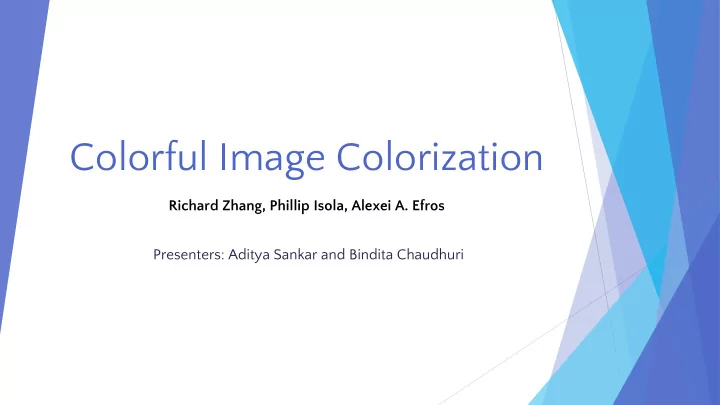

Colorful Image Colorization Richard Zhang, Phillip Isola, Alexei A. Efros Presenters: Aditya Sankar and Bindita Chaudhuri
Introduction ❖ Fully automatic approach (self-supervised deep learning algorithm) ❖ Aim: estimate the 2 unknown color dimensions from the known color dimension ❖ Under-constrained problem; goal is not to match ground truth but produce vibrant and plausible colorization ❖ “Colorization Turing test” to evaluate the algorithm
Related Work Non-parametric methods: ▶ Use one or more color reference images provided by user based on input grayscale image ▶ Transfer color to input image from analogous regions of reference image(s) ▶ Parametric methods: ▶ Learn mapping functions for color prediction ▶ Generally on smaller datasets and using smaller models ▶ Concurrent methods: ▶ Iizuka et. al.[1] - Two-stream architecture; regression loss; different database ▶ Larsson et. al.[2] - Un-rebalanced classification loss; use of hypercolumns ▶ [ 1 ] Iizuka, S., Simo-Serra, E., Ishikawa, H.: Let there be Color!: Joint End-to-end Learning of Global and Local Image Priors for Automatic Image Colorization with Simultaneous Classification. ACM Transactions on Graphics (Proc. of SIGGRAPH 2016) 35(4) (2016) [ 2 ] Larsson, G., Maire, M., Shakhnarovich, G.: Learning representations for automatic colorization. European Conference on Computer Vision (2016)
Network architecture CIE Lab color space used for perceptual similarity to human vision ▶ Input: ; H,W – image dimensions ▶ Intermediate result: ; Q = 313 quantized ab values ▶ Output: ▶
ab - Space and Need for Rebalancing Quantized ab Color Space Empirical probability Illustration of Z distribution within ab space
Methodology CNN maps X to Z • Ground truth Y is mapped to Z using a soft-encoding scheme • • CNN is trained to minimize the following multinomial cross-entropy loss: • Weights v are added to take care of class imbalance
Methodology (Cont.) Z finally mapped to Y using the annealed mean of the color distribution. Mean of distribution produce spatially consistent but desaturated results Mode of distribution produce vibrant but spatially inconsistent results
Experimental Details ▶ Data used: ▶ 1.3 million training images from ImageNet training set ▶ First 10K images for validation from ImageNet validation set ▶ A separate set of 10k images for testing from ImageNet validation set ▶ CNN trained on various loss functions ▶ Regression (L2-loss) ▶ Classification, without rebalancing ▶ Classification, with rebalancing (Full method) ▶ Larsson, Dahl methods ▶ Random colors and gray scale images
Qualitative Results
Qualitative Results (contd..)
Failure Cases
Legacy Images Results with legacy black and white photos
Quantitative Results Measure of ‘Perceptual Realism’ via Amazon Mechanical Turk ▶ Real v/s Fake two-alternate choice experiment ▶ 256x256 image pairs shown for 1 second ▶ Turkers select the ‘real’ image for 40 pairs ▶ ▶ Ground Truth v/s Ground Truth will have expected result of 50% ▶ Random baseline produced 13% error (seems high) Ground Truth Random Dahl [2] Larrson [23] Ours [L2] Ours [L2, ft] Ours (Class) Ours (Full) “Better than Ground Truth results” Labeled Real 50 13.0 ± 4.4 18.3 ± 2.8 27.2 ± 2.7 21.2 ± 2.5 23.9 ± 2.8 25.2 ± 2.7 32.3 ± 2.2
Other Observations - Semantic Interpretability : - How does the colorization effect object detection? - VGG Object detection on ground truth images: 68.30% - VGG Object detection on desaturated images: 52.70% - VGG Object detection on (their) re-colorized images: 56.00% - VGG Object detection on Larsson re-colorized images: 59.40% - Raw Accuracy: - L2-distance from ground truth ab values - Predicting grey values actually performs quite well for L2 and Larsson outperforms them in this metric - They rebalance color weights by frequency of occurrence and in this rebalanced metric outperform Larsson and Grey scale.
Conclusion and Discussion Deep learning and a well-chosen objective function produce results ▶ similar to real color photos. Network learns a representation; can be extended to object detection, ▶ classification and segmentation Visual results are great. Quantitative metrics and other observations are ▶ just OK.. Need to consider global consistency and contextual information for ▶ complex scene colorizations
THANK YOU
Recommend
More recommend